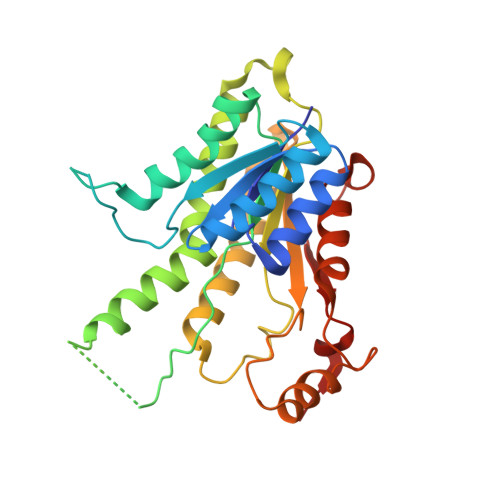Structures of Leishmania Major Pteridine Reductase Complexes Reveal the Active Site Features Important for Ligand Binding and to Guide Inhibitor Design
Schuettelkopf, A.W., Hardy, L.W., Beverley, S.M., Hunter, W.N.(2005) J Mol Biol 352: 105
- PubMed: 16055151
- DOI: https://doi.org/10.1016/j.jmb.2005.06.076
- Primary Citation of Related Structures:
2BF7, 2BFA, 2BFM, 2BFO, 2BFP - PubMed Abstract:
Pteridine reductase (PTR1) is an NADPH-dependent short-chain reductase found in parasitic trypanosomatid protozoans. The enzyme participates in the salvage of pterins and represents a target for the development of improved therapies for infections caused by these parasites. A series of crystallographic analyses of Leishmania major PTR1 are reported. Structures of the enzyme in a binary complex with the cofactor NADPH, and ternary complexes with cofactor and biopterin, 5,6-dihydrobiopterin, and 5,6,7,8-tetrahydrobiopterin reveal that PTR1 does not undergo any major conformational changes to accomplish binding and processing of substrates, and confirm that these molecules bind in a single orientation at the catalytic center suitable for two distinct reductions. Ternary complexes with cofactor and CB3717 and trimethoprim (TOP), potent inhibitors of thymidylate synthase and dihydrofolate reductase, respectively, have been characterized. The structure with CB3717 reveals that the quinazoline moiety binds in similar fashion to the pterin substrates/products and dominates interactions with the enzyme. In the complex with TOP, steric restrictions enforced on the trimethoxyphenyl substituent prevent the 2,4-diaminopyrimidine moiety from adopting the pterin mode of binding observed in dihydrofolate reductase, and explain the inhibition properties of a range of pyrimidine derivates. The molecular detail provided by these complex structures identifies the important interactions necessary to assist the structure-based development of novel enzyme inhibitors of potential therapeutic value.
Organizational Affiliation:
Division of Biological Chemistry and Molecular Microbiology, School of Life Sciences, University of Dundee, Dundee DD1 5EH, UK.
















